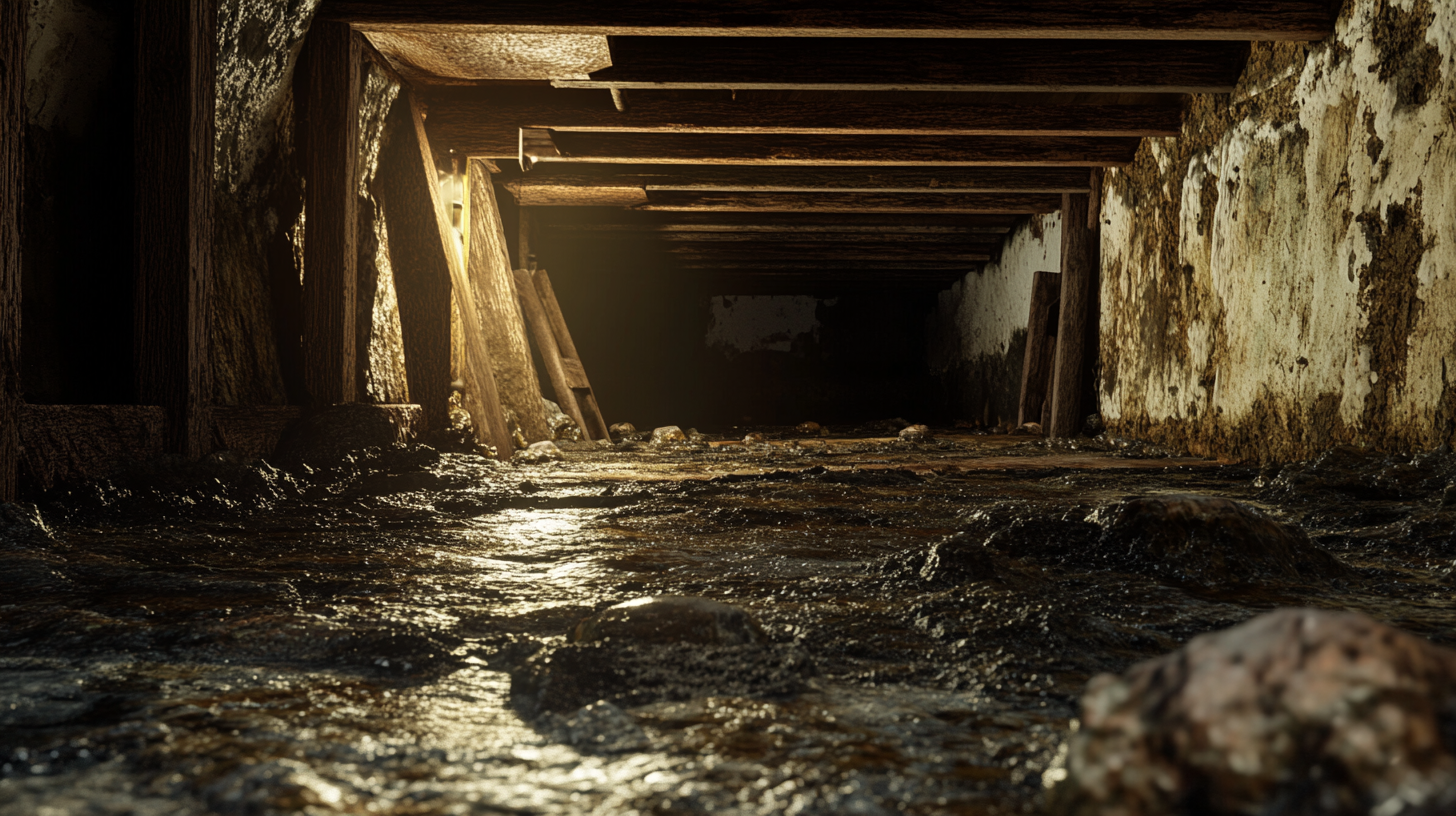Now IS THe Time To...

Crawl Space Services In Knoxville, TN
Stetson Howard: 865-432-6743
CRAWL SPACE ENCAPSULATION, REPAIR, WATERPROOFING & MOLD REMOVAL
No-Obligation, Free Inspections
No-Obligation Free Estimates
We Warranty All of Our Work
100% Satisfaction Guaranteed
Waterproofing is a crucial element in both construction and renovation projects, serving as the foundation for protecting structures from water damage. Whether building new homes or updating existing ones, proper waterproofing ensures the longevity and durability of key areas such as foundations, roofs, and bathrooms. Without adequate waterproofing, structures are vulnerable to water infiltration, which can lead to structural damage, mold growth, and costly repairs. By investing in the right waterproofing materials and techniques, homeowners and builders can safeguard their projects against moisture-related issues and enhance the overall value of the property.
Understanding Waterproofing Membranes
Waterproofing membranes are essential components in modern construction, playing a crucial role in protecting buildings from water damage. Whether you're working on a new build or a renovation, choosing the right membrane is key to ensuring long-lasting protection and structural integrity.
What are Waterproofing Membranes?
Waterproofing membranes are specialized materials designed to create a continuous barrier that prevents water from penetrating into surfaces such as roofs, basements, and walls. These membranes can be applied as sheets, liquids, or sprays and form a protective layer over the structure, keeping water out and moisture at bay. By preventing water infiltration, waterproofing membranes safeguard key areas from the risks associated with water damage, such as mold growth, structural weakening, and corrosion.
Key Functions of Waterproofing Membranes:
- Barrier Protection: Waterproofing membranes act as a physical shield, keeping water and moisture from entering sensitive parts of the building.
- Longevity: By preventing water from seeping into foundations, walls, or roofs, these membranes significantly extend the lifespan of structures, reducing the need for frequent repairs or rebuilding due to water-related issues.
- Versatility: Waterproofing membranes are used across various surfaces, including flat roofs, basement walls, balconies, and bathrooms, making them an integral part of both residential and commercial projects.
The Importance of Choosing the Right Type of Waterproofing
Selecting the right waterproofing membrane is vital for the success of any construction or renovation project. With various types of membranes available, each suited to different environments, choosing the right one can prevent costly repairs and ensure long-term protection.
Factors to Consider When Choosing Waterproofing Membranes:
- Project Location: The location of the project influences the choice of waterproofing material. For example, buildings in areas with heavy rainfall or near bodies of water may require stronger, more durable membranes like bituminous membranes or EPDM rubber to withstand constant exposure to moisture.
- Environmental Exposure: External areas like roofs or balconies are exposed to direct sunlight, temperature fluctuations, and weather extremes, which can degrade some materials over time. Membranes that offer UV resistance and flexibility, such as polyurethane or liquid-applied membranes, are ideal for these environments. In contrast, interior spaces like basements may benefit from cementitious or bentonite waterproofing, which provides reliable protection against groundwater.
- Budget Considerations: The upfront cost of waterproofing should be weighed against long-term durability. High-quality materials like EPDM rubber may cost more initially but provide long-lasting protection, reducing the need for reapplication or repairs. Meanwhile, more affordable options like bituminous coatings or cementitious waterproofing may be suitable for smaller-scale projects but could require more frequent maintenance.
By carefully selecting the right type of waterproofing membrane based on these factors, homeowners and builders can ensure that their projects remain protected from water damage for many years, avoiding costly and disruptive repairs down the line.
Overview of Liquid Waterproofing Membranes
Liquid waterproofing membranes are a versatile and highly effective solution for protecting surfaces from water infiltration. Used in a wide range of residential and commercial applications, these membranes offer flexibility, durability, and seamless coverage, making them ideal for surfaces that experience movement or exposure to the elements.
How Liquid Waterproofing Membranes Work
Application:
Liquid waterproofing membranes are applied as a liquid that spreads over the surface, then hardens to form a seamless, waterproof layer. This method allows the material to conform to any surface, including complex shapes and irregular areas, providing comprehensive protection against water penetration.
Composition:
Liquid membranes are typically made from materials like polyurethane, acrylic, or bitumen, each offering distinct advantages depending on the specific application. These materials provide excellent water resistance and flexibility, ensuring long-term durability even in challenging environments.
Curing Process:
Once applied, liquid membranes go through a curing process, where the liquid solidifies into a continuous, durable layer. Proper curing is essential to the membrane’s performance, as it ensures that the material bonds fully to the surface, creating a strong, water-tight seal. After curing, the membrane becomes flexible yet tough, offering long-lasting protection against moisture and water damage.
Types of Liquid Waterproofing Membranes
There are several types of liquid waterproofing membranes, each suited to different applications based on the project’s needs and environmental conditions.
- Polyurethane Liquid Membranes:
These membranes are known for their high flexibility and durability, making them ideal for roofs, terraces, and areas exposed to movement or temperature changes. Polyurethane membranes can handle significant expansion and contraction, preventing cracking over time. - Acrylic Liquid Membranes:
Acrylic-based membranes offer excellent UV resistance, making them particularly suitable for exterior applications such as roofs and balconies. They provide a reflective surface that helps prevent degradation from sunlight while maintaining flexibility. - Bitumen-Based Liquid Membranes:
Commonly used in foundation and below-grade waterproofing, bitumen-based membranes provide strong water resistance and are highly effective at preventing groundwater infiltration. These membranes are especially useful in environments where moisture is constantly present, like basements and retaining walls.
Advantages of Liquid Waterproofing Membranes
Liquid waterproofing membranes offer several advantages that make them a popular choice for many construction and renovation projects.
- Seamless Application:
One of the most significant benefits of liquid membranes is that they form a seamless, continuous layer over the surface. This eliminates the weak points and joints commonly found in sheet or roll-on materials, reducing the risk of water penetration through cracks or seams. - Flexibility:
Liquid membranes are highly flexible, making them perfect for areas with complex shapes or irregular surfaces. They can easily conform to corners, edges, and other hard-to-reach areas, providing consistent protection. Their flexibility also makes them ideal for surfaces that experience movement, such as roofs and terraces. - UV Resistance:
Many liquid membranes, especially those made from acrylic and polyurethane, offer strong UV resistance, ensuring they remain effective even when exposed to direct sunlight. This makes them an excellent choice for exterior surfaces, where they can endure long-term exposure to sunlight without degrading.
Limitations of Liquid Waterproofing Membranes
While liquid membranes offer many benefits, they do come with certain limitations that need to be considered for successful application.
- Curing Time:
Liquid membranes require a curing period after application, during which the surface must remain undisturbed. Depending on the material and environmental conditions, this curing time can range from a few hours to a few days. Any disturbance during this period can affect the membrane’s integrity, leading to weak spots or failure. - Moisture Sensitivity:
Humidity and wet conditions can impact the membrane’s effectiveness during application. Applying a liquid membrane in high-moisture environments can interfere with proper curing, resulting in compromised waterproofing performance. It’s essential to ensure that the surface is dry and that weather conditions are favorable before beginning the application process. - Requires Skillful Application:
For best results, professional application may be necessary. Achieving even coverage and preventing thin spots can be challenging, especially on large or complex surfaces. Professional installers have the experience and tools to ensure the membrane is applied uniformly and effectively, providing maximum protection.
Overview of Sheet Waterproofing Membranes
Sheet waterproofing membranes are a reliable and durable option for protecting structures from water infiltration. These pre-manufactured membranes come in rolls and are installed by adhering or fastening them to the surface, providing long-lasting waterproof protection for areas such as roofs, foundations, and basements. In this section, we’ll explore how sheet membranes work, the different types available, and their advantages in construction and renovation projects.
How Sheet Waterproofing Membranes Work
Application:
Sheet waterproofing membranes are pre-manufactured and rolled out over the surface that needs protection. They are then either adhered using special adhesives or mechanically fastened to the structure. The sheets are applied in an overlapping manner, with the seams carefully sealed to create a continuous waterproof barrier. This method ensures that the entire surface is protected from water penetration.
Composition:
These membranes are made from various materials, including bitumen, PVC, and EPDM (synthetic rubber), each offering distinct properties that make them suitable for different applications. The material choice depends on the specific needs of the project, such as flexibility, UV resistance, or long-term durability.
Installation Process:
During installation, the sheets are typically rolled out and secured to the surface either through adhesives or mechanical fasteners. Overlapping edges are then sealed to ensure no gaps remain where water could penetrate. This installation process is faster than liquid membranes since no curing time is required. The sealing of overlaps is critical to ensuring the membrane remains watertight and provides complete coverage.
Types of Sheet Waterproofing Membranes
There are several types of sheet waterproofing membranes, each designed for specific applications and offering unique benefits.
- Bituminous Membranes:
Bituminous sheet membranes are among the most widely used waterproofing systems, particularly for flat roofs and foundations. Made from asphalt-based materials, they provide excellent durability and water resistance. Bituminous membranes are also cost-effective, making them a popular choice for both residential and commercial projects. - EPDM Membranes:
EPDM (Ethylene Propylene Diene Monomer) is a synthetic rubber membrane known for its flexibility and long-lasting durability. It is ideal for flat roofs, basements, and areas exposed to frequent movement or temperature fluctuations. EPDM membranes offer superior resistance to UV rays, ozone, and weathering, making them suitable for long-term outdoor use. - PVC Membranes:
PVC (Polyvinyl Chloride) membranes are lightweight, flexible, and UV-resistant, making them a great choice for roofing systems. These membranes are easy to install, can be heat-welded for a seamless finish, and offer excellent resistance to chemicals and weathering. PVC is commonly used for flat and low-slope roofs where a durable, flexible waterproofing solution is needed.
Advantages of Sheet Waterproofing Membranes
Sheet waterproofing membranes offer several advantages that make them a dependable choice for various construction and renovation projects.
- Pre-Manufactured Consistency:
One of the key benefits of sheet membranes is their pre-manufactured consistency. The membranes are produced in factories to a uniform thickness, ensuring that there are no weak spots or variations in coverage. This consistent thickness helps reduce the risk of water infiltration and ensures reliable protection across the entire surface. - Durability:
Sheet membranes are known for their high resistance to tears, punctures, and environmental factors like UV exposure. This makes them ideal for areas that experience high foot traffic or are exposed to the elements, such as roofs or balconies. The robust nature of sheet membranes means they can withstand wear and tear, offering long-term protection. - Fast Installation:
Compared to liquid membranes, sheet waterproofing membranes can be installed more quickly, as there’s no need to wait for curing. This makes them a time-efficient solution for larger projects. Once applied and sealed, they provide immediate protection against water, allowing construction to continue without delays.
Best Uses for Liquid Waterproofing Membranes
Liquid waterproofing membranes are a versatile and highly effective solution for many types of surfaces, especially where traditional sheet membranes may fall short. Their ability to form a seamless, flexible layer makes them ideal for challenging areas that require comprehensive waterproofing. Here are some of the best uses for liquid waterproofing membranes in residential and commercial projects.
Complex or Irregular Surfaces
One of the key advantages of liquid waterproofing membranes is their ability to conform to complex or irregular surfaces. When applied, the liquid spreads across the surface and fills in tight corners, curves, and uneven areas, ensuring seamless protection.
Common Applications:
- Bathrooms: Bathrooms often have multiple fixtures and tight corners that require precise waterproofing. Liquid membranes provide full coverage in hard-to-reach areas like around pipes, drains, and under bathtubs.
- Balconies: Balconies with railings, posts, and edges benefit from the flexibility of liquid membranes, which can easily be applied to every surface, regardless of shape.
- Roofs with Multiple Angles: Roofs with slopes, angles, and intersecting surfaces can be difficult to waterproof using rigid materials. Liquid membranes provide a smooth and uniform waterproofing solution, even for the most intricate roof designs.
Areas Prone to Movement
Liquid membranes are especially well-suited for areas that experience movement, such as expansion and contraction due to temperature changes or structural shifts. These membranes remain flexible even after curing, allowing them to accommodate any shifts without cracking or losing effectiveness.
Examples:
- Roof Terraces: Roof terraces are exposed to the elements and temperature fluctuations, leading to expansion and contraction of materials. Liquid membranes can adapt to these movements, maintaining a watertight seal.
- Surfaces with Temperature Fluctuations: Areas like flat roofs or external walls that experience thermal expansion benefit from the flexibility of liquid membranes, which can handle these shifts without compromising their waterproofing properties.
Small or Confined Spaces
Another great use for liquid waterproofing membranes is in small or confined spaces where traditional sheet membranes may be difficult to apply. Because the liquid is easy to work with and can flow into narrow or awkward spaces, it is the ideal choice for areas where precision is required.
Applications:
- Bathrooms: In small, confined spaces like around showers or bathtubs, liquid waterproofing is much easier to apply than sheets, which may require cutting and shaping to fit.
- Tight Corners and Edges: In places where surfaces meet at tight angles or in complex geometries, liquid waterproofing ensures that every part of the surface is fully covered, providing a continuous and uniform barrier that sheet membranes may not easily achieve.
Common Mistakes to Avoid in Waterproofing Membrane Selection
Choosing the right waterproofing membrane is critical to the success of your project, but it’s equally important to avoid common mistakes that can compromise the performance of these systems. From proper surface preparation to considering environmental conditions, overlooking key factors can lead to ineffective waterproofing and costly repairs down the line. Below are the most common mistakes to avoid when selecting and applying waterproofing membranes.
Ignoring Surface Preparation
Proper surface preparation is essential for the effectiveness of any waterproofing system. Whether you’re using liquid membranes or sheet membranes, failing to thoroughly clean and prepare the surface can severely impact the adhesion and performance of the membrane.
- Liquid Membranes: For liquid membranes to bond correctly, the surface must be clean, dry, and free of dust, dirt, and debris. If the surface is not properly prepared, the liquid membrane may peel or crack over time, allowing water to penetrate.
- Sheet Membranes: Similarly, sheet membranes require a smooth, clean surface to adhere properly. Any dirt or unevenness can create air pockets or weak spots where water could infiltrate, undermining the entire waterproofing system.
Avoid this mistake by ensuring surfaces are properly cleaned and prepared before applying any waterproofing membrane. This step is crucial to achieving long-lasting protection.
Skipping Professional Help
While some waterproofing systems may seem straightforward to install, professional expertise is often necessary, especially for more complex installations like sheet membranes. One of the most common mistakes is attempting to install these systems without professional guidance, which can lead to poor performance and potential failure.
- Sheet Membranes: Properly installing sheet membranes requires precision, particularly when it comes to seam sealing. If the seams are not sealed correctly, water can penetrate through the gaps, compromising the membrane’s waterproofing abilities. This is a critical task best left to professionals who have the experience and tools to ensure a seamless installation.
- Complex Surfaces: For surfaces with intricate shapes, multiple angles, or tight corners, professional installers are better equipped to handle the complexities of applying membranes effectively, ensuring every part of the surface is adequately covered.
Hiring a professional not only ensures proper installation but also saves you from costly repairs down the road by guaranteeing the membrane performs as intended.
Overlooking Environmental Conditions
One of the most overlooked factors in waterproofing projects is the impact of environmental conditions during application and curing. Liquid membranes, in particular, can be sensitive to weather, and failing to consider these conditions can result in poor membrane performance.
- Rain and Humidity: Applying liquid membranes in rainy or humid conditions can prevent them from curing properly, leading to an incomplete or weakened waterproofing layer. Moisture can interfere with the bonding process, making the membrane less effective and more prone to damage over time.
- Temperature Fluctuations: For both liquid and sheet membranes, extreme temperatures during application can affect performance. Applying membranes in very hot or cold conditions may cause them to cure too quickly or too slowly, resulting in uneven coverage or compromised durability.
To avoid this mistake, always check the weather forecast before beginning your waterproofing project and ensure that environmental conditions are ideal for the membrane’s application and curing process.
FAQs
Recent Blog Posts
Crawl Space News







